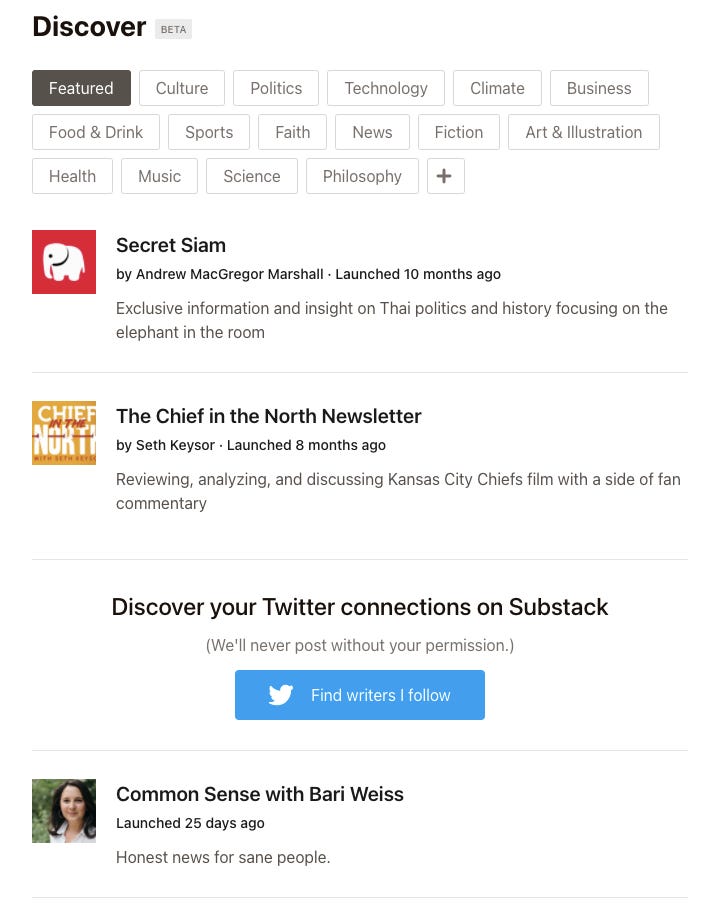#62 - Will Twitter Kill Substack?
Big Tech Embraces Newsletters
A clown car that fell into a goldmine. That’s what Facebook CEO Mark Zuckerberg once called Twitter. Despite its ubiquity in entertainment and media, Twitter has perennially punched below its weight financially. Executive turnover has been high. Development velocity has been low. Yet clowns can be scary, especially when they’re gunning for your goldmine.
Twitter’s New Paywall
In a podcast last year, Substack’s co-founder and CEO Christ Best said that newsletters were one of the few places left online where readers could have a relationship that wasn’t controlled by big tech. No longer. On January 26, Twitter acquired Revue, a Dutch newsletter start-up and Substack competitor. Facebook is circling newsletters too.
It’s a smart acquisition. Twitter now directly benefits from creator economy growth. Writers already use the platform to connect with readers and build their audiences. Of the 528 accounts I follow on Twitter, 111 write on Substack (this probably isn’t representative, but still). Revue closes the loop and monetizes existing behavior. The acquisition makes Twitter a one-stop-shop for writers offering acquisition, distribution, hosting, and promotion. It also generates subscription revenue, diversifying Twitter away from advertising. Lastly, it opens up paid promotion opportunities. Writers can use ads to grow subscribers and revenue.
The old meme was that Substack is Twitter’s paywall. Now, Twitter is Twitter’s paywall. The bull case is that Twitter ads can be to creators what Facebook ads are to SMBs. The bear case is the clown car.
David versus Goliath Algorithms
This spells trouble for Substack. Founded in 2017, the company now has over 500,000 monthly paying subscribers and millions of readers. Substack’s growth is impressive, but its numbers are dwarfed in absolute terms by Twitter, with over 180 million daily users, and Facebook, with nearly two billion. Existing networks are an advantage for acquiring readers and writers.
Scale isn't Twitter’s only advantage. In the same podcast, Best highlights several of Substack’s priorities: driving new subscribers, building tools for promoting newsletters, and improving recommendations. Better discovery is the key theme. At heart, discovery is matchmaking. Writers want more readers. Readers want more relevant content. Good discovery tools connect the two. Between its ad tech and its recommendation engine - who to follow, what’s happening - Twitter already has these capabilities.
What’s more, Substack’s existing discovery tools leverage Twitter, suggesting that the platform is an important acquisition channel. One tool scans who you follow on Twitter, highlights who writes on Substack, and offers one click sign-up:

Another, Substack Discover, prominently features the Twitter discovery tool:

Twitter has advantages in distribution, resourcing, and scale. But that’s not all. It also has a pricing edge. Revue charges writers 5% (plus payment fees), compared to Substack’s 10% rake (plus payment fees). Writers keep more of what they make on Revue. Goliath is half-off David.
Damn The Torpedoes, Full Speed Ahead
More competition for hosting writers is a plus for creators, but it’s a less rosy outcome for Substack. The company's response: bring it on.
Substack’s path forward is to become the best home for writers. This is a fight it can win. To start, Substack should cut its fees from 10% to 5%. This is a hard decision, but the right one. It would halve Substack’s revenue. It would also mean that the company has less to invest in headcount and product development. Fortunately, the venture capital funding market is very accommodative right now. Lower growth likely impacts valuation, but Substack can raise capital.
This capital should be invested in product improvements and building writer community. Twitter has distribution and discovery advantages, but Substack can still make discovery improvements. Adding tools for bundling and cross-promotion would make relationships stickier and create new business opportunities for writers. Substack is a leader in providing legal support to writers. Though it won’t be cheap, it should press on with writer benefits. Lastly, it should invest in fostering writer community. One or two community manager and a few Slack channels for writers focused on growth, tips, and swapping war stories could pay dividends. If Twitter wants to become the Amazon of newsletters, Substack can be the Etsy.
Focus on Focusing
Goliath doesn’t always win. For Substack, Snapchat versus Facebook is an interesting parallel. Snapchat is Facebook’s R&D department. It develops features like stories and filters that Facebook copies shortly thereafter. Facebook’s user base, headcount, and cash balance are more than an order of magnitude larger than Snapchat’s. Yet Snapchat keeps innovating, driving higher user engagement and strong revenue growth.

To succeed, Substack should follow Snap’s lead: move fast and keep innovating. Twitter has more users, more headcount, and more cash. It’s also trying to do a lot more. Substack can focus. It can be nimble. Speed and focus could overcome Twitter’s scale. For example, Spotify credits its focus on audio as an advantage over competition from Apple, Amazon, and Google. Clowns can be scary, but Substack might still have the last laugh.
Stop clowning around and subscribe 🤡 🤡 🤡:
👉 If you enjoyed reading this post, please share it with friends!




